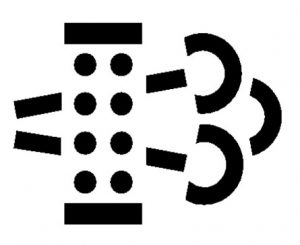Modern tractors are wonders of engineering. They have highly efficient engines, and the systems designed to comply with Tier 4 regulations makes then run much cleaner by reducing toxic gases and solid particulates. And that makes the air you breathe cleaner and healthier while you’re working all day.
The device used to deliver clean emissions is called a Diesel Particulate Filter (DPF), and it can get gunked up with soot every now and then. The cleaning process is called the regen process. Your tractor has a dash symbol that tells you when regen is necessary. The symbol is the same across all major brands. It looks like this:

When the dpf filter is dirty and needs to regenerate, the regeneration indicator will flash. When the indicator light flashes, regen needs to happen immediately. Here’s what you need to know.
Auto Regen
Some tractors are equipped with auto regen mode. If you’re working and the conditions are met for auto regen, it will start automatically and you can continue working as normal. To meet the conditions, the tractor must be warmed up and the engine RPMs above 1800. You must keep the RPMs up during the regen, which will last about 15 minutes. If you’re doing something that requires high RPMS, like tilling or mowing, you may not even notice the process is happening, because there is nothing for you to do.
During this time, the indicator light stops blinking and is on and steady. If it starts blinking again, you need to increase RPMs.
CAUTION:
If your tractor has auto regen mode and you want to continue to work, make sure you’re working in a well-ventilated area with non-combustible materials. The process generates a lot of heat.
Once the process has started, don’t interrupt regeneration by lowering the RPM or shutting off the tractor. If that happens, diesel can contaminate the oil.
Parked Regen
Parked regen is a more manual process that requires you to stop working. When the regen light comes on, here’s what you do:
- Park your tractor on a flat surface in a well-ventilated area.
- Keep the engine running in idle.
- Engage the brake.
- Put all shift levers in neutral. Turn off PTO.
- Warm up the engine. It should be running for at least 3 or 4 minutes before starting regen.
- Press and hold the regeneration button for a few seconds, until the regen warning light goes off and the regen process light starts to blink.
- Wait for the process to finish, about 30 to 40 minutes.
During the regen process, the engine will idle higher as the RPMs are increased, and there will be a burning smell as particulates are incinerated.
How Often Does my Tractor Need Regen?
The rate of particle accumulation, and how often you need to regenerate depends on several factors, including your specific brand and model and how it is used. More particulates are generated during warmup from a cold start and while idling. The more you idle, the faster your filter will get dirty and the more frequently it will need to regenerate.
Particulates accumulate more slowly as you’re working because higher RPMs burns them off naturally. High RPM jobs, like mowing, burn off particulates, while low RPM jobs, like loading result in higher particulate accumulation.
So that’s it, all pretty easy as long as you know what’s going on. This is a general overview, so be sure to consult your manual about where the buttons, lights, or indicator symbols appear on your specific model.
Sources:
Kubota Tractor Manual regen section









